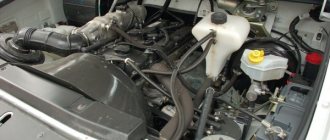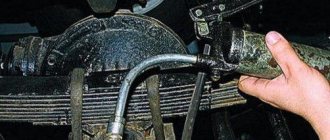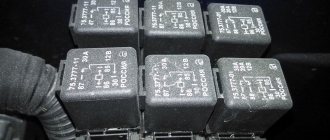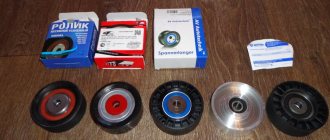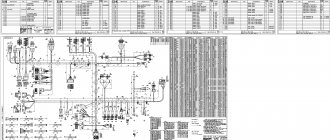The cooling system of the UAZ Patriot engine contains an element called a “viscous coupling” or, as it is sometimes called, a “fluid coupling” - on which the fan is located. It is necessary to protect against overheating and is activated only when the engine temperature begins to exceed operating limits.
The viscous coupling on the UAZ Patriot is designed in such a way that it is connected to the engine crankshaft not directly, but through special disks, between which there is a working fluid. When starting a cold engine, the viscous coupling spins at a very low speed, much less than the number of engine revolutions.
Then, as the engine warms up, the metal plate in front of the viscous coupling heats up from the radiator and bends outward, which releases a special ball that closes the hole in the inner disk. It turns out that the working fluid has nowhere else to go and remains between the disks.
The working fluid used is a special one, so-called “dilatant”, based on silicone. When heated and stirred, it expands and becomes more like thick glue. Next, the fan speed increases to eventually equal the crankshaft speed. A serviceable clutch turns with little effort when the engine is turned off.
How to remove a fan pulley on a ZMZ 409
To cool the radiator, a fan is used, driven from the engine crankshaft through a special clutch.
Under prolonged loads and elevated air temperatures, the performance of the impeller is not enough to remove heat. Find out how to install an electric fan on a UAZ Patriot instead of a viscous coupling.
Installing an electric fan on the UAZ Patriot instead of a viscous coupling allows you to increase the air flow drawn through the radiator honeycombs and improve the temperature parameters of the power unit under conditions of increased load.
Recommendations
Comments 52
Thanks, I'll get to it soon.
I also threw out the temple, installed a vent from the hover, the next step is to install the cover without a pulley, question about the belt, did it fit correctly? A car with air conditioning?
Fits just right, with air conditioning
Or maybe take a 2000 belt and throw out the deflection pulley.
This twin is not suitable; the blades are sharpened to work in front of the radiator; you need a twin from a Chevy Niva or Nissan.
This twin is useless, you should install a Nissan one
“WHISKY” still has a plus. When the engine is warm in the summer, it smoothly picks up speed and stays at approximately the optimal speed (doesn’t suck too much). The same cannot be said about the electric Carlson. I went hunting last summer, drove through flowering fields, in short, a lot of fluff... and pollen. The result, for example, Niva 214, there is a fur coat on the front... I have an adequately clean radiator... Even the front Carlson did not turn on, i.e. whiskey was enough to keep the engine temperature normal - t
In the heat of summer, yes, there is a plus. In my area, 8 months a year the temperature rarely rises above 10 degrees, even one fan copes with more than enough. And with whiskey in winter, there is underheating and excessive consumption of gasoline.
“WHISKY” still has a plus. When the engine is warm in the summer, it smoothly picks up speed and stays at approximately the optimal speed (doesn’t suck too much). The same cannot be said about the electric Carlson. I went hunting last summer, drove through flowering fields, in short, a lot of fluff... and pollen. The result, for example, Niva 214, there is a fur coat on the front... I have an adequately clean radiator... Even the front Carlson did not turn on, i.e. whiskey was enough to keep the engine temperature normal - t
And the fan fuse will never blow)
I put the key in and with a sharp blow of a rubber hammer it came out immediately. It also twists. For those who doubt electro. A question to answer the question: the Japs and GAZelles have electric and normal ones, but they are warm in winter.
I tried this method, the pulley slipped. then I tried using a screwdriver to fix the slightly unscrewed pulley bolts - I bent them for nothing (
Well, the idea of removing the viscous coupling passed when I saw melted hot-melt adhesive that was used to seal the end of the steering shaft. Kind of hints about the temperature under the hood, right? And this is with forced cooling. But the question is different: will the standard fans blow in the right direction? They are designed for installation in front of the radiator.
change the polarity and it should be fine
The essence of the problem
The viscous coupling is a sealed housing filled with a viscous silicone-based working fluid. Inside the casing there are 2 disks with guide vanes; torque is transmitted by oil flows.
The characteristics of the liquid allow you to smoothly regulate the rotation speed of the output shaft and the fan impeller installed on it. The design ensures that the thermal regime of the motor is maintained at medium and high speeds.
When the engine speed drops to idle mode, the intensity of mixing of the working fluid in the clutch body decreases, which causes a decrease in the fan speed. A drop in air flow speed causes the radiator and engine jacket to overheat. The problem occurs when driving in long traffic jams or when driving on rough or swampy terrain at low speed.
An additional concern is the safety of the structure. In the center of the coupling there is a bimetallic plate that controls the bypass valve.
When the element is cooled (by the air flow from the radiator), the impeller rotates at low speed.
As the element warms up, the valve closes, and then the impeller accelerates sharply. At this point, there is a risk of injury to the driver servicing the engine. There have been cases of plastic impeller rupture (due to previous damage).
Viscous cooling fan coupling: where it is located and how it works
The fan rotation speed changes smoothly, steplessly; a fan with a viscous coupling never turns on and off instantly
In all-wheel drive transmissions of passenger vehicles with a longitudinal engine position, a standard viscous coupling performs the functions of an ersatz differential or a special locking element that complements a conventional differential. However, from a design point of view, the device is represented by a plurality of round driving and driven plate elements with projections and holes, which are located inside a completely waterproof housing filled with dilatant liquid.
The fan rotation speed depends on the heating of the engine: the more the viscous coupling is heated, the more the inlet channel opens, and the more liquid enters the working chamber.
In the absence or insignificant volume of automobile oil inside the working chamber, free rotation of the drive disk is observed. Only in the process of gradual warming up of the engine and increasing the temperature of the antifreeze does the bimetallic plate heat up and expand, which causes the opening of the intake valve system, penetration of the working fluid into the chamber and an increase in the speed of rotational movements of the ventilating impeller. As the adhesion coefficient decreases, the difference in the rotational speed of the housing and the viscous coupling drive shaft increases noticeably, which slows down the operation of the fan impeller.
Role in the internal combustion engine cooling system
A viscous coupling fan is installed on vehicles with a longitudinal engine (usually all-wheel drive and rear-wheel drive models). With this arrangement, it is most advisable to connect the radiator fan pulley to the water pump pulley. As you know, rotation of the water pump is transmitted by a service belt from the crankshaft pulley.
The disadvantage of this design is that the rotation speed of the fan impeller will always be proportional to the crankshaft speed. Such a device will result in the engine being excessively cooled at high speeds in cold air conditions, which will reduce its efficiency. In addition, the permanent connection of the impeller and the crankshaft pulley will increase mechanical friction losses, which will take away power and increase fuel consumption.
The viscous fan coupling allows you to adjust the rotation speed of the impeller depending on the engine temperature.
Device
The difference in the design of viscous fan couplings for Toyota, BMW, Mercedes, Audi. is minimal, since they are all designed and work according to the same principle.
A shaft with a connecting flange is attached to the cooling pump drive, so its rotation speed is always proportional to the crankshaft speed. A drive pulley, in turn, is attached to the shaft, which rotates in the working chamber. The working and backup chambers are separated by plates. The transition between chambers is only possible through inlet valves and return passages. Initially, the backup chamber is filled with special silicone oil. The drive pulley, or disk, as it is also called, has oblique teeth around its circumference, which, when rotated, allow the oil to be expelled back into the reserve chamber. The surface of the drive disks, like the dividing plates, has special ribs that turn the working chamber into a kind of network of labyrinths through which silicone oil circulates.
How to check a viscous coupling (using the example of UAZ Patriot)
The engine cooling system of the UAZ Patriot is equipped with a standard viscous coupling with a fan. This device provides reliable protection against overheating by turning on when the engine temperature goes beyond the established operating parameters. The viscous coupling does not have a rigid connection to the crankshaft, and starting a cold engine causes it to rotate at low speed.
It is very difficult to independently diagnose a breakdown of a viscous coupling in normal mode, but there are several ways to easily verify the functionality of such a device. To check the viscous coupling of the UAZ Patriot cooling fan, you should take a closer look at the speed of the mechanism when the engine is turned on, cold and warm.
Fault diagnosis
The principle of operation of the device is simple - at low coolant temperatures, a spring located inside the viscous coupling holds both valves closed, which prevents the free flow of coolant in it. With gradual heating, the valves open, causing liquid to circulate inside, causing the fan to move. At low temperatures, the fan speed is low, and its rotation can easily be stopped by hand, whereas at high temperatures this is not possible.
Carefully! Trying to stop the fan from moving by hand by jamming the blades can result in serious injury. The use of foreign objects may cause the blades to break.
If the fan spins weakly at high engine temperatures, then it is definitely necessary to replace it. It is prohibited to operate a vehicle with a faulty valve, as this may cause the engine to overheat.
About the electric fan
The electric fan covers all the disadvantages that the viscous coupling had. After installing it, it will be difficult not to notice the following improvements:
From the factory, on a UAZ Patriot with air conditioning, a so-called “sparka” is installed in front of the air conditioner radiator (on the street side) - two electric fans in a plastic case. But they have little effect on the main radiator, and besides, they make a lot of noise. Therefore, if you have already decided to install electric fans instead of a viscous coupling, you can safely remove them.
Installation process
To install an electric fan, it is not at all necessary to visit a service center; everything can be done independently at home. First of all, it is necessary to select or manufacture a base for electric fans (frame or “screen”) that matches the size of the engine cooling radiator.
DIY troubleshooting
Standard disassembly of a viscous coupling involves removing the device, dismantling the impeller, unscrewing a pair of mounting pins, draining the working fluid, thoroughly washing the inside with gasoline and drying it. After filling with new PMS-10000 silicone oil, the device is mounted back.
To troubleshoot a viscous coupling or replace it, you must first remove the device:
- Remove the fan casing by removing the pins and spacer clips.
To make the key fit, its ends can be sharpened with a grinder
You need to press the belt between the temple pulley and the power steering pulley
Insert the key from above between the two blades
If the cause of incorrect operation of the viscous coupling is a leak of silicone liquid from the base, then the following actions are performed:
If there is a variety of unusual noise in the cooling radiator, the bearing will need to be replaced. For this purpose, it is necessary to drain the oil and disassemble the assembly using a special puller. After installing the new bearing, the device is mounted in the reverse order, after which new silicone fluid is poured.
A special automotive device - a viscous coupling that rotates the cooling fan using liquid - quite often fails. It is possible to fix only the simplest breakdowns on your own, so in the most difficult cases you need to contact a service center with auto mechanics who specialize in working with these types of devices.
Electric Fan Installation
Replacing viscous couplings with electric fans begins with purchasing or making your own metal support frame for electric motors, which is then placed on the inside of the radiator.
On some vehicles equipped with an air conditioning system, an additional air conditioning heat exchanger with electric fans (installed on the outside of the radiator) is used. It is not recommended to remove the elements as they are controlled by the air conditioning controller to keep the air inside the vehicle cool.
For cooling, 2 fans from the Gazelle or from the “classic” VAZ models are used. When purchasing an impeller, you should consider the direction of air flow created by the blades. Additionally, it is necessary to replace the sensor in the thermostat housing, which activates the operation of the electric motors.
There are several types of sensors that are triggered at a liquid temperature of +87...+97°C. An additional toggle switch for manually turning on the engines is located in the car interior (on the dashboard or center console between the seats).
It is allowed to use fan units from Nissan X-Trail SUVs, which are equipped with a 4-channel patch cable. The devices are connected to the power unit control controller and to a temperature sensor (with a response threshold increased to +95...+97°C).
Installing an electric fan is very simple.
The signal from the control unit turns on the impellers with an operating capacity of 40% of the maximum value. With a further increase in temperature, a sensor located in the thermostat housing is triggered, allowing the fans to be switched to maximum air supply.
There have been cases of using a fan from Hover (catalog number 1308100K00V1), which is equipped with additional resistance to obtain 2 speeds of rotation of the impeller. The product is supplied with a plastic frame, which is installed on the UAZ Patriot radiator with minor modifications.
Before installation, you will need to cut down 2 support brackets, which are placed on the lower edge of the plastic diffuser. For mounting, standard holes on the radiator are used, intended for installing the original guide casing.
Installing an electric fan on a UAZ Bukhanka
The clutch allows you to reduce fuel consumption, reduce fan noise, and promotes better warm-up of a cold engine.
The viscous clutch is removed if it malfunctions, if the clutch does not turn on or does not turn on completely.
You will need a 32 key.
View of the viscous coupling assembled with the fan
To make it easier to unscrew the coupling, unscrew one pin
Unscrew the coupling shaft from the fan drive hub
Please note that the connection between the coupling and the hub has a left-hand thread
Remove the viscous coupling assembly with the fan
Unscrew the four nuts securing the fan to the coupling
Remove the fan from the coupling
Install the fan and clutch in reverse order
UAZ Patriot - viscous coupling replacement
In the UAZ Patriot there is an element called a “viscous coupling” or, as it is sometimes called, a “fluid coupling” - on which the fan is located. It is needed to protect against overheating and is activated only in this case, when the motor temperature begins to go beyond the operating limits.
The viscous coupling on the UAZ Patriot is designed in such a way that it is connected to the engine crankshaft not directly, but through special disks, between which there is a working fluid. When starting a cool engine, the viscous coupling rotates at a very low speed, even lower than the number of engine revolutions.
Then, as the engine warms up, the iron plate in the front part of the viscous coupling heats up from the radiator and bends outward, which releases a special ball that closes the hole in the inner disk. It turns out that the working water has nowhere else to go and remains between the disks.
Timing belt disassembly procedure
Next, proceed to removing the timing parts. To navigate the location of the timing parts relative to the motor, use the attached timing diagram of the ZMZ-409 motor.
Dismantling the timing belt is done in the following order. Having unscrewed the bolts from the cover of the upper hydraulic tensioner 8, remove it together with the gasket. Specifically, under the hydraulic tensioner cover there is a spring that requires care when removing. After removing the spring, pull out the hydraulic tensioner itself. In the same way, remove the lower hydraulic tensioner 2.7. Next, unscrew the seven bolts securing the chain cover. It is necessary to remove the cover carefully, because there is a risk of breaking the crankshaft front oil seal, or one of the gaskets: the chain cover and the cylinder head. Unscrew the upper tension device. Disconnect the tensioner lever 7 and the gear. Similarly, disconnect the lever and gear of tensioner 3. Disconnect gears 12 and 14 from the camshaft flanges using a special puller. After unscrewing the bolts, remove the middle chain guide 16. Gears 5 and 6 are secured to the intermediate shaft with 2 bolts and a locking plate. Unscrew the bolts by bending the edges of the plate and holding the shaft from turning with a screwdriver through the hole in gear 5. Remove gear 6 from the shaft using a chisel as a lever. Remove the gear together with chain 9. Remove gear 5 from the shaft, pull it out and chain 4. To remove gear 1 from the crankshaft, first remove the bushing and remove the o-ring. After which you can press out the gear.
Service
Maintenance of power units of all types for the “Loaf” is given in the same way. All these engines were developed on the basis of the legendary ZMZ 402, and therefore the maintenance for them is approximately the same.
For representatives of UMZ 417 and 421, engine maintenance is carried out almost similarly. Thus, scheduled maintenance is carried out every 15,000 km. Maintenance includes changing the oil and filter. To change the oil, you will have to unscrew the drain plug and wait for the lubricant to drain. Then, the plug is screwed in and oil is poured through the filler neck. The oil filter is changed when there is no oil in the engine.
Maintenance also includes checking all systems for oil leaks and malfunctions. Every 30,000 km the valves must be adjusted, and every 20,000 km the air filter element must be replaced.
The essence of the problem
Let's start with the fact that the engineer of the Ulyanovsk Automobile Plant equips UAZ Patriot SUVs with radiator cooling fans, which are driven by a viscous coupling.
A viscous coupling is a mechanism presented in the form of two flat disks. Viscous coupling allows you to transmit torque using a special silicone-based fluid.
The operating principle consists of several plates mounted on the driven and drive shafts. They rotate in a container with liquid, which changes its properties when heated. When the liquid is mixed while the drive shaft rotates, it changes its properties (expands) and thereby creates pressure in the chamber. As a result, the disks of the driven shaft engage, causing it to move.
What it is
Viscous coupling is a drive component that transfers power and torque from the center drive shaft to the front differential and wheels. Inside the coupling is a dilatant fluid that hardens when subjected to shear forces generated by the input and output shafts rotating at different speeds. The input shaft is connected to the rear wheels. The output shaft is connected to the front wheels. When the front and rear wheels rotate at different speeds (at speeds greater than 6%), the shear force increases the temperature and viscosity of the dilatant inside the viscous coupling.
The fluid becomes solid and binds the plates inside the unit, causing power to be transferred from the center drive shaft (motor) to the front differential (front wheels). When the front and rear wheels begin to rotate again at relatively equal speeds, the fluid "deactivates", becoming less viscous and more fluid, causing control of the device to switch to the drive wheels.
Key for removing viscous coupling on UAZ Patriot ZMZ 409
Key for removing viscous coupling on UAZ Patriot ZMZ 409
Post by lexmak » May 28, 2022, 02:51 pm
Any factory key for 32 with a thickness of no more than 9 mm. Found in nature.
Well, that's all.
Key for removing viscous coupling on UAZ Patriot ZMZ 409
Post by igorstrong » 06 Jun 2022, 07:30
Key for removing viscous coupling on UAZ Patriot ZMZ 409
Post by lexmak » 06 Jun 2022, 17:49
Select the vehicle modification to search for a viscous coupling
Engine: volume - 2.4 liters, power - 75 hp, type - petrol, model - UAZ427810. Drive: full. Year of manufacture: 2003-present. time
Engine: volume - 2.4 liters, power - 98 hp, type - petrol, model - UMZ 4178.10. Drive: full. Year of manufacture: 1999-present time
Engine: volume - 2.7 liters, power - 128 hp, type - petrol, model - ZMZ-409.10. Drive: full. Year of manufacture: 2004-present time
Engine: volume - 2.9 liters, power - 84 hp, type - petrol, model - UMZ-4218. Drive: all-wheel drive. Year of manufacture: 1998-present. time
Engine: volume - 2.9 liters, power - 86 hp, type - petrol, model - UMZ-4218. Drive: all-wheel drive. Year of manufacture: 2004-present time
Engine: volume - 2.2 liters, power - 91 hp, type - diesel, model - ZMZ-5143.10. Drive: full. Year of manufacture: 2002-present. time
Engine: volume - 2.2 liters, power - 92 hp, type - diesel, model - YA3151. Drive: full. Year of manufacture: 2007-present time
Engine: volume - 2.4 liters, power - 86 hp, type - diesel, model - YA331514U. Drive: full. Year of manufacture: 2002-present. time
In the next step, for an expanded selection, you can enter the vehicle's Vin code to go to illustrated catalogs, where you can find the layout of parts down to the bolt and duplicates that are not in the catalog of analogues.
